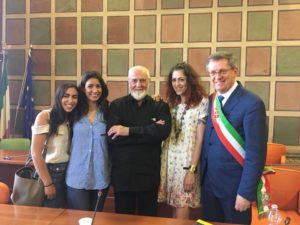From 27th May to 2nd September 2018, the Gothic church of Santa Maria della Spina in Pisa will host a Third Paradise. Pistoletto’s sign-symbol is part of the exhibition The Time of Judgement, also occupying the Sala delle Baleari in Palazzo Gambacorti, the city’s municipal building.
Curated by Ludovico Pratesi, it is the fifth of a series of site specific installations within this church, which places national and international contemporary artists in dialogue with the sculptures of Romanesque-Gothic masters like Giovanni Pisano, Andrea Pisano and Lupo di Francesco.
The symbol of the Third Paradise is the reconfiguration of the mathematical sign for infinity: the two side circles, representing the world’s opposites, are linked by a central circle, a womb generating a new society and new values.
For this exhibition, the sign was realized using fifty chairs of different provenance and, at the artist’s request, charged with an emotional value: the specificity of the installation is in fact given by the involvement of the local population, who had the opportunity to lend their chairs for the duration of the exhibition to become part of a work of art. In this version, the Third Paradise is brought to life by an ordinary object which carries the lives and experiences of different citizens, who meet generating art.
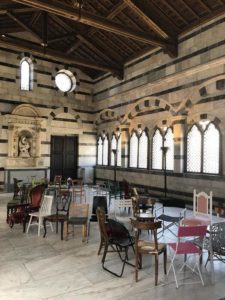
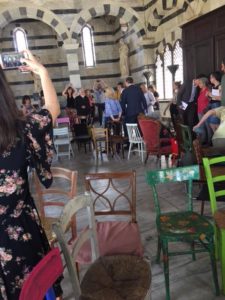
The first chair to arrive was the one decorated by the elderly guests of Villa Isabella, who had painted it turning into a colourful and cheerful object. A lady brought the last chair belonging to her late mother, whose name is carved on its back. Three children have participated with their wood, bamboo and “lion” chairs. A former student brought the chair which has accompanied him move after move. The association La Rinascita, a historical Arci club, has lent one of its chairs as a symbol of sharing and welcoming. Among the others, a psychotherapist’s chair and a chair a citizen is particularly attached to, even if he found it by chance. The chair-sculpture by two artists, Cristina Carmassi and Marc Pozzi, stands out, made with recycled material. There have been contributions from institutions too, from the Graphic Museum at the University of Pisa, for example, which has lent one of the chairs of Palazzo della Giornata, the site of the dean’s office. A chair from the mayor’s office comes from the municipal building and a Howe 40/4, by the designer David Rowland, from the Comel Foundation.
The second part of the exhibition focuses on The Time of Judgement (2009): the work-temple has been placed within the Sala delle Baleari, in Pisa’s municipal building, once again in dialogue with frescos from the second half of the 1600s, attributed to Giacomo Farelli and Pier Dandini, and representing historical victories of the Republic of Pisa. The installation consists of four wall-mounted mirrors, in front of which are the symbols of four main religions: Christianity, Buddhism, Islamism and Judaism are invited, through their reflections in the mirrors, to meditate on themselves and their quintessential aspects, inducing us to do the same.
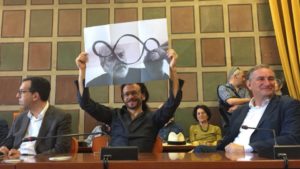
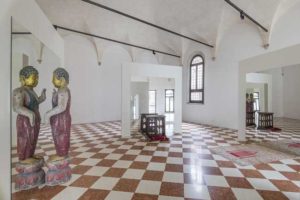
“The social and cultural value of Pistoletto’s thought – writes Ludovico Cortesi on the leaflet of the exhibition – has led contemporary art into the Sala delle Baleari, a place which is a symbol of the city of Pisa and its identity, where the artist delivers a deep message of hope, making us reflect on the essence of the religious message”.
